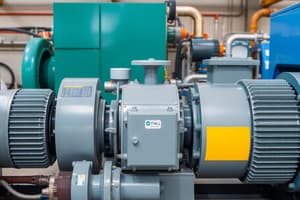Podcast
Questions and Answers
Explain the significance of back EMF in DC motors and provide the EMF equation.
Explain the significance of back EMF in DC motors and provide the EMF equation.
The back electromotive force (EMF) is the voltage induced in the armature of a DC motor due to the rotation of the armature within the magnetic field. It opposes the applied voltage and limits the armature current. The EMF equation for a DC motor is given by $E = V - I_a \times R_a$, where $E$ is the back EMF, $V$ is the applied voltage, $I_a$ is the armature current, and $R_a$ is the armature resistance.
Discuss the types of DC motors, including their characteristics.
Discuss the types of DC motors, including their characteristics.
There are three main types of DC motors: series-wound, shunt-wound, and compound-wound. Series-wound DC motors have high starting torque but poor speed regulation. Shunt-wound DC motors have relatively constant speed and are used in applications requiring consistent speed. Compound-wound DC motors combine the characteristics of both series and shunt-wound motors, providing good starting torque and speed regulation.
Explain the construction and working principles of a three-phase induction motor.
Explain the construction and working principles of a three-phase induction motor.
A three-phase induction motor consists of a stator with three-phase windings and a rotor with conductors. When a three-phase supply is connected to the stator windings, a rotating magnetic field is produced, inducing a current in the rotor conductors. This interaction creates a torque, causing the rotor to rotate. The motor operates on the principle of electromagnetic induction.
Describe the basic principle of Faraday’s law of electromagnetic induction.
Describe the basic principle of Faraday’s law of electromagnetic induction.
What are the variables used in electrical machines, and how are they related to power?
What are the variables used in electrical machines, and how are they related to power?
Flashcards
Back EMF
Back EMF
Voltage induced in a DC motor's armature due to rotation in a magnetic field, opposing the applied voltage and limiting armature current.
Series-Wound DC Motor
Series-Wound DC Motor
Motors with high starting torque but poor speed regulation, where the field winding is connected in series with the armature.
Shunt-Wound DC Motor
Shunt-Wound DC Motor
Motors with relatively constant speed, used where consistent speed is needed. Field winding is connected in parallel with the armature.
Three-Phase Induction Motor
Three-Phase Induction Motor
Signup and view all the flashcards
Faraday’s Law of Electromagnetic Induction
Faraday’s Law of Electromagnetic Induction
Signup and view all the flashcards
Study Notes
Back EMF in DC Motors
- Back EMF (Electromotive Force) is a significant concept in DC motors as it opposes the change in current flow, reducing the overall current drawn from the source.
- The back EMF equation is: Eb = (PΦn)/60, where Eb is the back EMF, P is the number of poles, Φ is the magnetic flux, and n is the speed in rpm.
Types of DC Motors
- Shunt Wound Motors: Characterized by a constant speed, suitable for applications requiring a fixed speed, such as fans and centrifugal pumps.
- Series Wound Motors: Exhibits high starting torque, commonly used in applications like cranes and hoists that require high starting torque.
- Compound Wound Motors: Combines the characteristics of shunt and series wound motors, offering high starting torque and constant speed, typically used in traction and lifting applications.
Three-Phase Induction Motor
- Construction: Consists of a stator (stationary part) and a rotor (rotating part), with the stator carrying three-phase windings and the rotor carrying a squirrel cage or wound rotor.
- Working Principle: The three-phase AC supply creates a rotating magnetic field that induces an EMF in the rotor, causing it to rotate.
Faraday's Law of Electromagnetic Induction
- Basic Principle: A changing magnetic flux induces an EMF in a conductor, with the magnitude of the induced EMF proportional to the rate of change of the magnetic flux.
Electrical Machines and Power
- Variables: Voltage (V), Current (I), Power (P), and Energy (E) are the fundamental variables in electrical machines.
- Relationship with Power: Power (P) is the product of voltage (V) and current (I), i.e., P = V × I, and is a measure of the rate at which energy is transferred or converted.
Studying That Suits You
Use AI to generate personalized quizzes and flashcards to suit your learning preferences.




